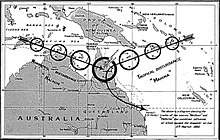@Scott th RatbagGiven this occurred in 1899 you are talking total crap and have no idea about what the shit hitting the fan is actually like >
Storm path of Cyclone Mahina, 1899
Tropical Cyclone Mahina struck Australia on 4 March 1899,[4]with a likely minimum central pressure of 880 millibars (26 inHg).[5][1]Mahina ranks among the most intense cyclones ever observed in the Southern Hemisphere and almost certainly as the most intense cyclone ever observed off theEastern states of Australiain recorded history.[6][3]Clement Lindley Wragge, Government Meteorologist forQueensland, pioneered the naming of such storms and gave this storm its name,Mahina.
Storms of such intensity occur extremely rarely. Scientists identified two otherCategory 4or 5 super-cyclones that struck Australia, in the first half of the 19th century, from their effects on theGreat Barrier Reefand theGulf of Carpentaria. This same research shows that on average, such super-cyclones occur in the region only once every two or three centuries.[7]
A pearling fleet, based atThursday Island, Queensland, was anchored in or near the bay before the storm. Within an hour, the storm drove much of the fleet ashore or onto the Great Barrier Reef; other vessels sank at their anchorages. Four schooners and the mannedChannel Rocklightship were lost. A further two schooners were wrecked but later re-floated. The fleets lost 54luggers, and a further 12 were wrecked but re-floated. People later rescued more than 30 survivors of the wrecked vessels from the shore; however, the storm killed more than 400 people, mostly non-European immigrant crew members.[8][9]A depiction of the schoonerCrest of the Wavein the storm was later sketched in a painting.[10]
A largestorm surge, reportedly 13 metres (43 ft) high, swept acrossPrincess Charlotte Bayand then inland about 5 kilometres (3.1 mi), destroying anything left of theBathurst Baypearling fleet and the settlement.[11]
An eyewitness,constableJ. M. Kenny, reported that a 48-foot (15 m) storm surge swept over their camp at Barrow Point atop a 40-foot (12 m)-high ridge and reached 3 miles (4.8 km) inland, the largest storm surge ever recorded.




